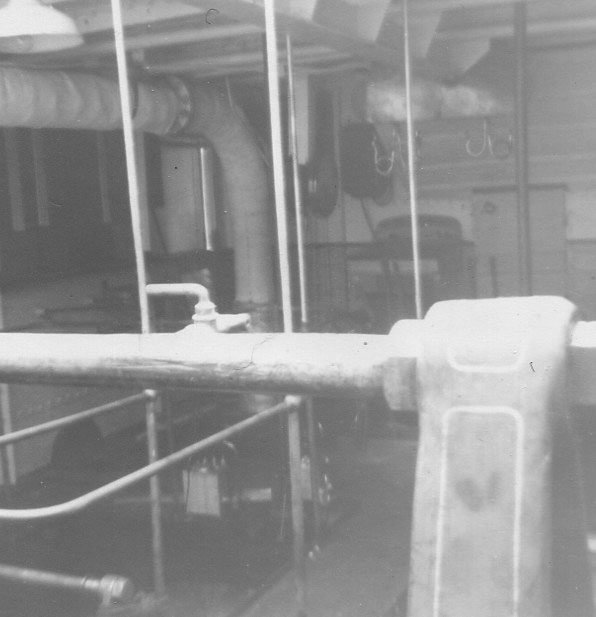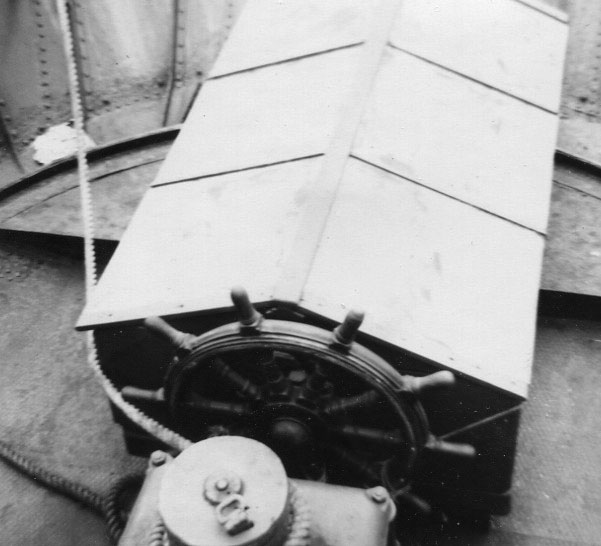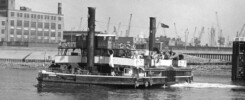
In the spring of 1967 a small group of PSPS Wessex Branch members visited the paddle steamer Embassy in the Backwater at Weymouth shortly before she was towed away to the scrapyard in Belgium. Embassy’s impending departure was seriously bad news. She was was the last purely excursion paddle steamer on the South Coast and whilst it was true that the Ryde remained in service, she offered only occasional Solent excursions and was primarily a ferry on the shuttle between Portsmouth or Southsea and Ryde. Besides, it could not be long before she too followed Embassy and then there would be none.
In this picture on the left is Peter Lamb, holding a sign for Embassy’s gents plucked from its usual home. Two along from him is my school-friend Richard Green with me on his left. We were both sixteen at the time and both pretty obsessed with paddle steamers. The bald headed man on my left is Jack Surfleet, Wessex Branch chairman for many years. The ladies in the front are, from left to right, Irene Waller, Adrienne Waller and Mrs Brookbanks. Mr Brookbanks is on the right behind.

Embassy’s buoyant apparatus were usually stacked up and covered with a tarpaulin during the winter but for this last lay-up they were left in their seasonal positions with their varnish exposed to the wind, rain and cold.

The lever on the left leading into the funnel was for moving the position of the boiler damper. Just forward of that is the small steam engine which drove a fan which sucked an induced draft though the furnace fire tubes and on up the funnel. With this system there was no need for a fully enclosed and pressurised boiler room as on the Waverley and many other paddle steamers. I recall Capt Defrates telling me that this steam engine made the whole bridge sort of vibrate making his false teeth rattle but he may have been saying that as it is the sort of thing which adults tend to say to boys to make them smile. However, apart from occasional relief trips in his early days as a master with Cosens, Capt Defrates never sailed as Embassy’s permanent master preferring the Monarch, which, like KC, ran on natural draft for her whole career and therefore never had a fan engine, and Consul which had her fan engine positioned aft of the funnel and away from the bridge.

The docking telegraph under its cover and the engine room telegraph on Embassy’s starboard bridge wing. The thing on the right of that with a handle was a knocker for ringing a bell on the forrard sponson to give orders to the man handling the spring rope. For example, one pull: hold on, two pulls: slack away and so on. The Waverley has similar knockers for communicating with the sponsons fore and aft incorporated into her docking telegraphs.

A view through the window (with its quayside reflections) of Embassy’s wheelhouse. There was not much kit as you can see: a binnacle, a wheel and wheel-stand and voice-pipes to the engine room and the captain’s cabin below the bridge. In her later years Embassy was fitted with a medium frequency ship to shore/ship radio but it was never installed on the bridge. Instead it found its residence in the purser’s cabin below the wheelhouse with a speaker extension onto the bridge so that the captain could hear what was being said but not transmit unless he went below to the radio itself.

Embassy was fitted with both a whistle and a siren with the latter the preferred mode of sound signal of her last master Capt John Iliffe, a former naval man, who perhaps liked to imagine himself back on wartime corvettes.






Embassy’s windlass and the wheel for her hand turned bow rudder. In her later years she used this all the time when running astern even when backing out from straightforward piers like Bournemouth. The captain on the bridge indicated to the man on the wheel in the bow what he wanted by pointing one way or the other with a special hand signal for amidships and steady.

I may be looking cheerful in this picture taken half a century ago but in truth it was a bleak afternoon for me. There was a certain amount of conviviality aboard with some helping themselves to souvenirs and others grabbing the opportunity to jangle the telegraphs in a reckless and end of term sort of way. But for me, it was the day when the penny finally dropped that paddle steamers were on the way out and that rather than find a career aboard them as I had hoped, I would have to look elsewhere to make a living doing something else instead. My feet seemed heavier than usual that afternoon as I trudged home up Boot Hill for tea.
Kingswear Castle returned to service in 2023 after the first part of a major rebuild which is designed to set her up for the next 25 years running on the River Dart. The Paddle Steamer Kingswear Castle Trust is now fund raising for the second phase of the rebuild. You can read more about the rebuilds and how you can help if you can here.
John Megoran


